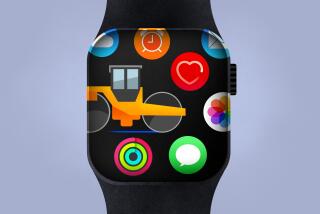How Long Can the IPod Stay on Top?
- Share via
Since the iPod’s debut in 2001, Apple Computer Inc. has worked feverishly to keep its iconic portable media player two beats ahead of the competition. Last week’s introduction of the iPod Hi-Fi home stereo was the latest in a rapid succession of updates and add-ons designed to maintain Apple’s dominance in digital music.
So far the strategy has worked. In January, iPods accounted for 78% of the portable music players sold in the United States, according to market research firm NPD Group. Apple’s online iTunes Music Store has sold more than 1 billion songs in three years and is transforming the way masses of people buy music and video.
But rivals around the world -- including titans Samsung Corp., Sony Corp. and Toshiba Corp. -- are catching up with devices that often are cheaper than Apple’s offerings and sometimes do more.
Some Apple watchers also suspect that the iPod’s innovation curve may be flattening as the company runs out of obvious ways to jazz up or shrink down its best-selling product.
Bigger hard drives? Been there.
Video? Done that.
FM tuner? Now an option.
Sleeker design? But of course.
“The music iPod was a tidal wave in the music industry,” said Rob Yarin, vice president for entertainment at Frank N. Magid Associates, a media consulting firm. “The video iPod is more than a ripple, but it’s not a tidal wave. Whether the addition of video is enough to keep the iPod in a leadership position is something Apple will have to keep an eye on.”
Despite iPod’s substantial lead in the market -- 42 million have sold since 2001 -- Apple is in no position to get comfortable. In many ways, the emerging market for portable media players mirrors the early PC market.
The runaway popularity of the iPod recalls the success of the iconoclastic company’s Macintosh personal computer, whose elegance and reliability made it a luminary of the digital age.
As rival computer makers churned out cheaper machines powered by Microsoft Corp.’s Windows operating system, though, Apple’s market share dropped steadily -- from 11.6% in 1994 to 4.2% today, according to research firm IDC Corp.
With the iPod, Apple is determined not to let history repeat itself.
“Our formula for success has been and still remains to make a better product than anyone else and to out-innovate everyone faster and better,” said Philip Schiller, Apple’s senior vice president for worldwide marketing. “So by the time they try to copy and target what we’ve done, we’ve already moved on.”
For now, Apple still dominates a relatively small niche.
Sure, iPods are ubiquitous in hipper circles. Snowboarders, bobsledders and ice skaters sported them at the Winter Olympics in Italy. In the U.S., though, just 15% of households have a digital music player, compared with 98% that own a television, 71% with a wireless phone and 73% with a PC, according to the Consumer Electronics Assn.
And despite the iTunes Music Store’s selling its billionth song and 12 millionth video, its success is dwarfed by the 599 million CDs and 1.1 billion DVDs sold in the U.S. last year, according to Nielsen SoundScan and Adams Media Research.
Apple’s competitors concede that the Cupertino-based company has won the first round, but they still see plenty of opportunity. Early leaders, they note, don’t always win. TiVo Inc., for instance, is synonymous with digital video recorders that can pause live television, but as demand for that type of device has grown, cable and satellite companies have taken control.
“The market is growing overall, not just for Apple,” said Louis Masses, Toshiba America’s director of business development. “Are we going head to head with Apple? No. Our approach is to give people an option.”
This month, Toshiba plans to release the second generation of its Gigabeat media player. Powered by Microsoft’s new Windows Mobile operating system, the device will play music, photos, home videos and downloaded movies and TV shows.
Samsung has a similar device arriving this month, Sony continues to enhance the capabilities of its hand-held PSP and Creative Laboratories seems always to be updating its extensive line of portable multimedia players.
Already, investors are getting nervous. Although Apple posted record earnings last quarter -- and hasn’t had an annual loss since 2001 -- its stock has fallen 22% from its 52-week high of $86.40 in January.
Among the challenges facing Apple is that digital media players are relatively simple to make. They’re basically a portable hard drive -- or, increasingly, flash memory -- and a liquid crystal display plus silicon and software to convert data to sound. The differentiating features boil down to the user interface and the design of the case.
Apple has excelled in both areas. The iTunes software that enables iPod owners to fill their players with music and video is easy to use and versatile. And iPod’s austere design has made it as much a fashion accessory as an entertainment device.
Los Angeles architect Patti Poundstone appreciates the curves of both of her aesthetically essential possessions: her iPod and her Volkswagen Passat.
Most of her 50 or so colleagues at KAA Design Group in Marina del Rey have variations of the iPod and regularly use them at work. “It’s the most must-have object for an architect,” Poundstone said.
But trends come and go -- especially in the technology industry.
Technology can be fleeting when it is developed for its own sake, said Van Baker, an analyst with market research firm Gartner Inc. “The ones that have staying power are ones that have appeal above and beyond the value of the technology itself, and clearly the iPod would fall in that category.”
Apple so far has been able to tap into shifting tastes and change the iPod with them.
“The thing that’s got most of their competitors scared is how fast they can move,” said Richard Doherty of technology consulting firm Envisioneering Group. “Because they don’t have an 85-person audio consumer marketing department spread over three continents, decisions can be made over dinner.”
Toshiba, Doherty said, “has to pull marketing people together from three continents -- during which time Apple will have come out with two new iPods.”
For example, Doherty said, Apple quickly developed the iPod nano, a flash memory-based player that’s no thicker than a couple of sticks of chewing gum.
“They get a deal on flash memory, and six weeks later there’s the nano,” Doherty said.
That speed was on display in 2005. Apple came out with three new versions between January and October: the screenless iPod shuffle, the slim iPod nano, which has a tiny color screen and also stores photos, and the video iPod, which plays videos and TV shows on its 2.5-inch screen.
“Saturday Night Live” spoofed the iPod’s lightning-like product cycle, with comedian Fred Armisen playing Apple Chief Executive Steve Jobs introducing the iPod Micro, the size of a paper clip. But wait -- as he is talking about it, the Micro is superseded by the iPod Pequeno, as small as a vitamin pill, which is replaced 30 seconds later by the iPod Inviso, the size and weight of a speck of dust.
“It holds 8 million songs, every photograph ever taken -- and ‘Pong,’ ” the Jobs character intones gravely.
Increasingly, the iPod is tied to Apple’s online iTunes store, which has branched out from 99-cent music downloads to video.
Apple is not the first or only provider of video over the Web, and its rivals are expanding their offerings. America Online Inc., Microsoft’s MSN, Yahoo Inc. and Google Inc. offer TV shows and clips, while Movielink and CinemaNow focus on feature films. Vongo is an Internet download service optimized for Windows Mobile.
While Google’s video site attracted 3.04 million U.S. users in December, MSN video had 9.46 million visitors and Yahoo’s video site drew 2.15 million, iTunes had 20.7 million visitors, according to Nielsen/NetRatings.
Google acknowledged in late January that it had mishandled the launch of its video store that month. Shows for sale were poorly promoted at Google Video, and customers couldn’t find hit TV shows such as CBS’ “CSI: Crime Scene Investigation” and “Survivor.”
“By comparison with what Apple has done with the iPod and iTunes, they fell far short,” Gartner analyst Allen Weiner said.
As Apple tries to keep the iPod fresh, a favorite of the rumor mill is that the company will try more directly to target the digital home. Its vehicle may be a device that can record, store and burn DVDs of photos, music and videos and beam them wirelessly around the house, similar to what “entertainment PCs” from rivals such as Hewlett-Packard Co. can do today.
But is that really a role for a beefed-up iPod?
“It’s a delicate balance: Do you go more to a living-room, stationary product or to a mobile device?” said Mike McGuire, a consumer technology analyst with Gartner. “Creating a product for which there’s not a tangible market is risky. The challenge is, which thing are they going to put their weight behind to go after in rich content?”
The iPod has the potential to change the very fabric of how people interact, some imaginative thinkers say. For now, it’s a static device -- you put stuff on, you play it back.
But Alex Soojung-Kim Pang, a research director at the Institute for the Future in Palo Alto, imagines a world where people socialize by tapping into strangers’ iPods in a cafe, on a train or at the gym.
“This provides opportunities to hear some new stuff, or at the very least take a break from your own music collection or strike up a conversation. ‘Oh, I see you have the Grateful Dead concert at Cornell in 1977. Wasn’t that a fantastic show?’ ” Pang said.
Such interaction would flip the conventional dynamics in which people are introduced before the talk may turn to music.
“There already is a sense among many iPod owners that they’re part of this iPod nation, and the sense of citizenship in this group makes it easier for people to adopt this sharing,” Pang said
For now, the ranks of iPod loyalists show no signs of thinning. The devices have changed the way some people run their lives. Ask Aliza Loewy, a musical theater performer who lives in the Hell’s Kitchen district of Manhattan. She switched from Windows to Macintosh computers all because of her iPod.
“We were willing to go out and replace all our computers with Macs just to be happy with the iPod,” she said. “Really and truly, it’s like a child to me.”






